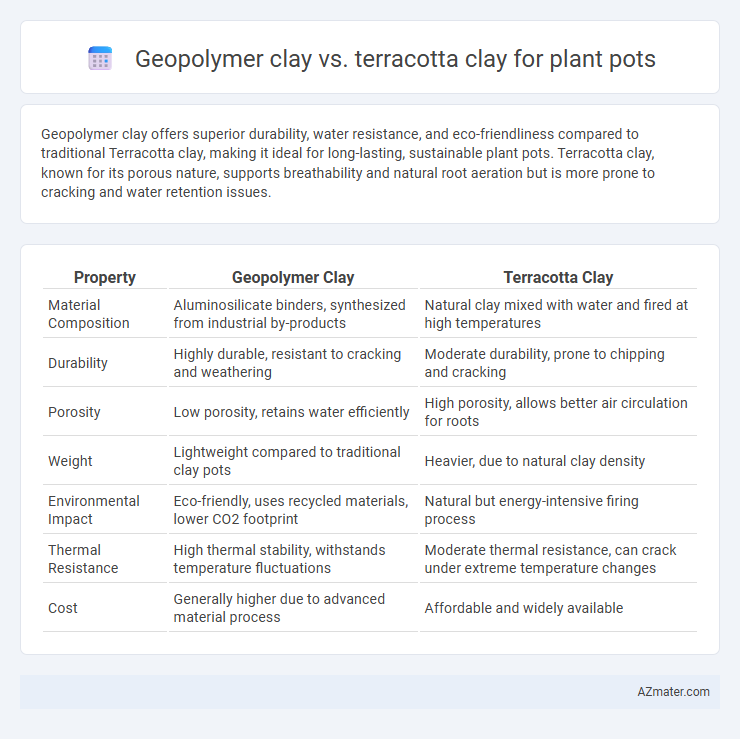Geopolymer clay offers superior durability, water resistance, and eco-friendliness compared to traditional Terracotta clay, making it ideal for long-lasting, sustainable plant pots. Terracotta clay, known for its porous nature, supports breathability and natural root aeration but is more prone to cracking and water retention issues.
Table of Comparison
| Property | Geopolymer Clay | Terracotta Clay |
|---|---|---|
| Material Composition | Aluminosilicate binders, synthesized from industrial by-products | Natural clay mixed with water and fired at high temperatures |
| Durability | Highly durable, resistant to cracking and weathering | Moderate durability, prone to chipping and cracking |
| Porosity | Low porosity, retains water efficiently | High porosity, allows better air circulation for roots |
| Weight | Lightweight compared to traditional clay pots | Heavier, due to natural clay density |
| Environmental Impact | Eco-friendly, uses recycled materials, lower CO2 footprint | Natural but energy-intensive firing process |
| Thermal Resistance | High thermal stability, withstands temperature fluctuations | Moderate thermal resistance, can crack under extreme temperature changes |
| Cost | Generally higher due to advanced material process | Affordable and widely available |
Introduction to Geopolymer and Terracotta Clays
Geopolymer clay is an innovative, eco-friendly material synthesized from industrial waste like fly ash and slag, offering high durability and chemical resistance for plant pots. Terracotta clay, a traditional natural clay composed mainly of iron-rich minerals, is renowned for its porous structure that allows excellent aeration and moisture regulation. Choosing between geopolymer and terracotta clays depends on factors such as sustainability preferences, durability needs, and desired aesthetic qualities for the plant pot.
Composition and Material Differences
Geopolymer clay consists of industrial byproducts like fly ash or metakaolin activated by alkaline solutions, resulting in a chemically bonded ceramic material known for high durability and resistance to heat and chemicals. Terracotta clay is primarily composed of natural iron-rich clay with silica and alumina, fired at lower temperatures to achieve its characteristic porous, reddish-brown finish ideal for plant breathability but less resistant to weathering. The key material difference lies in geopolymer clay's synthetic, inorganic polymer matrix providing superior mechanical strength compared to the traditional, porous, and softer structure of terracotta clay.
Strength and Durability Comparison
Geopolymer clay exhibits higher compressive strength and enhanced durability compared to traditional terracotta clay, making it more resistant to cracking and weathering. While terracotta is porous and prone to chipping under impact, geopolymer clay offers superior resistance to moisture absorption and thermal shock due to its inorganic polymer matrix. This increased strength and longevity make geopolymer clay a preferable choice for outdoor plant pots subjected to varying environmental conditions.
Water Absorption and Retention
Geopolymer clay exhibits significantly lower water absorption rates compared to terracotta clay, making it more resistant to moisture infiltration and reducing the risk of cracking. Terracotta clay, known for its porous nature, allows greater water absorption and improved aeration but tends to dry out faster, impacting water retention negatively. Choosing geopolymer clay for plant pots ensures better durability and consistent moisture levels, while terracotta pots require more frequent watering due to their higher porosity.
Breathability for Plant Health
Geopolymer clay offers superior durability but lacks the natural breathability of terracotta clay, which allows air and moisture to pass through, promoting healthier root systems and preventing waterlogging. Terracotta's porous structure enhances oxygen exchange and evaporation, crucial for maintaining optimal soil moisture and preventing root rot in plant pots. Selecting terracotta clay ensures better breathability, fostering improved plant health and growth compared to the denser, less permeable geopolymer clay.
Environmental Impact and Sustainability
Geopolymer clay offers a significantly lower carbon footprint compared to traditional terracotta clay due to its use of industrial by-products like fly ash and slag, reducing reliance on natural clay extraction and high-temperature kiln firing. Terracotta clay, while biodegradable and natural, demands extensive mining and energy-intensive firing processes that contribute to greenhouse gas emissions and habitat disruption. Choosing geopolymer clay for plant pots promotes sustainability by utilizing recycled materials and minimizing environmental degradation, making it a preferable eco-friendly alternative.
Aesthetic Qualities and Design Options
Geopolymer clay offers a sleek, modern aesthetic with smooth surfaces and the ability to incorporate vibrant pigments or metallic finishes, providing versatile design options for contemporary plant pots. Terracotta clay showcases a warm, rustic charm with its natural earthy tones and textured surfaces, often featuring traditional hand-crafted patterns that enhance its artisanal appeal. Both materials accommodate customization, but geopolymer clay allows for more intricate shapes and consistent finishes, whereas terracotta emphasizes organic imperfections and classic styles.
Cost and Affordability Analysis
Geopolymer clay offers a cost-effective alternative to terracotta clay for plant pots, as it utilizes industrial byproducts like fly ash, reducing raw material expenses and manufacturing energy consumption. Terracotta clay involves higher costs due to traditional mining, kiln firing at high temperatures, and longer production cycles, impacting its affordability. Geopolymer clay's lower material and processing costs translate into more affordable plant pots without compromising durability or aesthetic appeal.
Maintenance and Longevity
Geopolymer clay plant pots offer superior durability and low maintenance compared to traditional terracotta clay, as their synthetic composition resists cracking, chipping, and water absorption. Terracotta pots, while porous and breathable, require regular sealing and careful handling to prevent breakage and water damage over time. The longevity of geopolymer clay pots often exceeds that of terracotta, making them a practical choice for long-term plant care with minimal upkeep.
Final Verdict: Best Choice for Plant Pots
Geopolymer clay offers superior durability and resistance to weathering compared to terracotta clay, making it ideal for long-lasting plant pots. Its non-porous nature prevents water absorption, reducing the risk of root rot and enhancing plant health. Terracotta clay, although breathable and traditional, is prone to cracking under extreme conditions, positioning geopolymer clay as the best choice for modern, resilient plant pots.

Infographic: Geopolymer clay vs Terracotta clay for Plant pot
 azmater.com
azmater.com